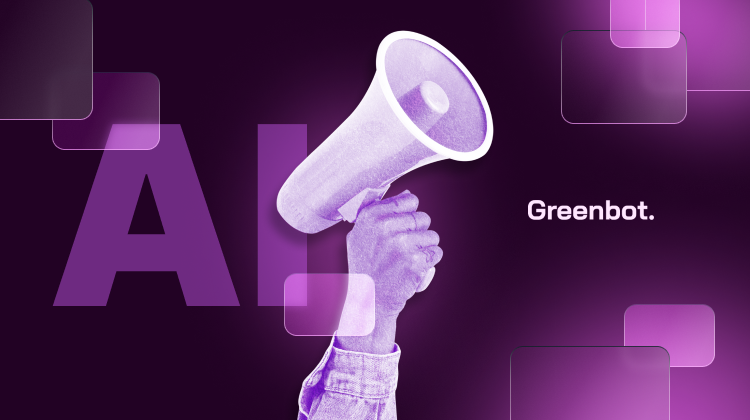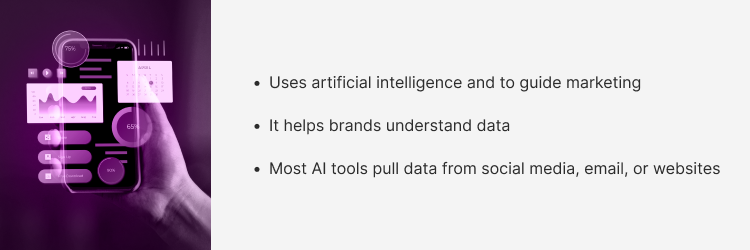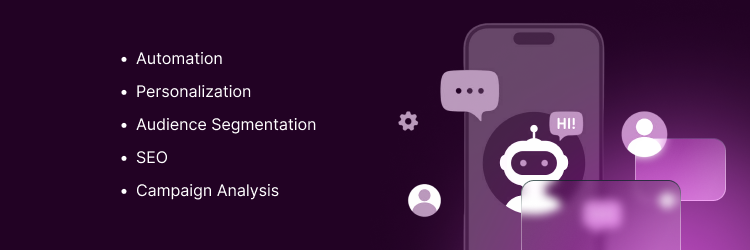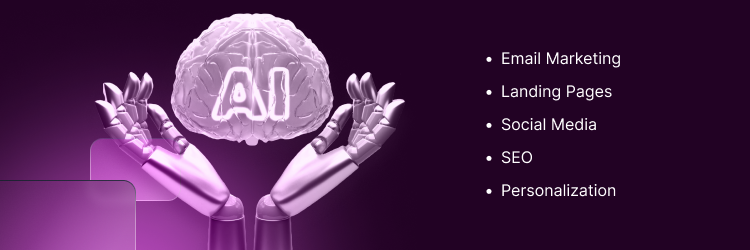
AI marketing is changing how brands reach people. Marketers now use AI tools to create content, target users, and get results faster. These platforms turn data into smart moves, helping teams work sharper—not harder. It’s not a trend. It’s today’s marketing strategy.
AI doesn’t replace creativity—it boosts it. Smart systems help teams spot patterns, test ideas, and adjust in real-time. They improve content creation, campaign flow, and ROI. With the right tools, marketing becomes more personal, efficient, and human-centered.
But what exactly is AI marketing? Let’s find out.
What Is AI Marketing?

AI marketing uses artificial intelligence and machine learning to guide marketing. It helps brands understand data and turn it into action.
Think chatbots answering customers, tools generating blog drafts, or predictive analytics targeting the right buyer. These systems cut guesswork and support stronger campaigns.
Most AI tools pull data from social media, email, or websites. They use it to guide every step—from idea to results. But to run them well, teams often need support from engineers or data scientists.
How AI Is Used in Marketing

Marketers use AI tools to move faster, spend less time guessing, and improve campaign results. Here’s how AI helps every day:
- Automation: Tools like Zapier and Hootsuite handle tasks like post scheduling and lead sorting.
- Personalization: Amazon recommends products based on browsing and buying habits.
- Audience Segmentation: Spotify targets listeners by genre, mood, or behavior.
- SEO: Surfer SEO and Clearscope suggest keywords and content updates based on trends.
- Campaign Analysis: Tools like Sprout Social track sentiment, engagement, and performance.
AI in Marketing Use Cases

AI marketing tools are changing how the marketing industry runs day-to-day campaigns. Below is a list of real-world examples across key marketing areas.
- Email Marketing: Mailchimp picks send times, subject lines, and content based on user behavior. Boosts clicks without manual edits.
- Landing Pages: Unbounce tests layouts and headlines. It applies what works automatically to improve page results.
- Social Media: Buffer and Sprout Social track post performance and recommend best times to publish.
- SEO: Surfer SEO and Clearscope suggest keywords and structure to match search intent.
- Personalization: Dynamic Yield and Adobe Target tailor site content live based on user activity.
Benefits of Using AI in Marketing
Here are some of the major benefits of using AI in marketing:
Faster, Smarter Decision-Making
AI tools like Jasper help teams instantly act on insights. Predictive models show what works before launch. You don’t guess—you test, tweak, and go.
Improved ROI on Marketing Initiatives
Jasper fine-tunes messaging in minutes. Better targeting cuts and waste. More engagement, less spend. Marketers get more value from every campaign.
More Accurate Measurement of KPIs
There is no more waiting for reports. Jasper connects each campaign step to performance. Dashboards show what works live, and teams adjust without losing momentum.
Enhanced CRM Capabilities
AI-powered systems sort contacts, track behavior, and suggest replies. Jasper keeps CRM messages relevant and fast—so teams don’t fall behind.
More Meaningful Insights from Customer Data
Jasper spots what humans miss. It scans clicks, purchases, and drop-offs to find trends. Marketers get real insights, not just stats.
Time Savings and Better Targeting
Jasper drafts blogs, ads, and emails in minutes. It slashes manual edits and helps teams deliver targeted campaigns faster.
Personalized Content and Real-Time Monitoring
Content updates live. Jasper tracks what users do and tweaks copy mid-campaign. That’s how brands stay sharp—and stay ahead.
>>Read our full Jasper review here!
How AI Improves Customer Relationship Management
AI tools make CRM faster and sharper. Chatbots handle basic questions. Sentiment analysis tweaks replies based on tone. No delays. No fluff.
These AI-powered tools track customer behavior, sort customer feedback, and send hyperpersonalized messages. Brands connect quicker and smarter—without drowning in manual tasks. That’s real AI integration in motion.
AI Tools That Help Streamline Workflows
Some of the most popular names include:
- Jasper: Builds blog posts, ad copy, and product descriptions fast. Great for on-brand content generation.
- ChatGPT: Writes responses, headlines, and scripts. Perfect for drafts and rewrites.
- Copy.ai: Tests landing page copy and slogans. Quick A/B testing tool.
- HubSpot AI: Automates outreach, scoring, and follow-ups. Solid for campaign flows.
- Grammarly Polishes content tone and grammar on the fly. For anything written.
- Rytr: Produces quick blurbs like captions or email intros. Good for small tasks.
- Hemingway app: Simplifies writing by cutting word bloat. Makes blogs clean and clear.
- Imagine Art Turns prompts into visuals. Ideal for creative assets or mockups.
- DeepAI: Edits images, creates videos, and generates AI art. Cuts down production time.
How Jasper Is Built for AI Marketing
Jasper isn’t just another AI tool—it’s built for marketers who want results fast.
- 90+ Marketing Apps: Jasper gives teams access to prebuilt AI tools focused on real campaign goals.
- KPI Alignment: Every feature connects to performance metrics and helps hit targets.
- AI-Powered Workflows: Teams use Jasper to build custom content workflows for blogs, ads, and emails.
- Generative AI for Marketing: It’s not general-purpose—it’s built for marketers who need fast, on-brand results.
- Personalized Content: Jasper tailors messaging to match tone, product, and audience behavior.
- Content Creation at Scale: Teams write, test, and publish faster—without starting from scratch.
- Built for AI Adoption: Whether you’re new or scaling fast, Jasper supports growth without friction.
Best Practices for Using AI in Marketing
These best practices help in using AI the right way—without losing control, clarity, or your message
- Set clear goals: Know what you’re fixing—speed, accuracy, or targeting.
- Use clean data: Garbage in, garbage out. Use real, updated info.
- Always review outputs: Don’t trust AI blindly. Check tone and facts.
- Watch for bias: Algorithms copy what they learn. Stay alert.
- Be transparent: Let your team know what’s AI-driven.
- Train your team: Everyone should know what the tools do and why.
- Track performance: Review metrics. Adjust tools to match results.
A Step-by-Step Guide to Incorporating AI Into Your Marketing Strategy
Many marketers want to integrate AI into their strategy to boost efficiency and engagement. The steps below offer a simple starting point—without overwhelming your team.
1. Define Goals
Decide what you want AI to fix—messaging, speed, targeting. Be specific.
2. Choose the Right Tools
Pick one or two AI-powered tools tied to real needs like content or CRM.
3. Train AI on Historical Customer Data
Use past data to guide AI. It sharpens accuracy and reduces trial time.
4. Launch Small Campaigns
Test the tool with a small audience. Watch and adjust.
5. Monitor Results and Improve
Measure against goals. Change what’s not working. Scale what works.
How to Do Digital Marketing With AI
AI powers every part of digital marketing. It helps plan, create, publish, and track content faster. Marketers use AI for content creation, scheduling, email marketing, and SEO—all while cutting guesswork.
- Email marketing: Tools like Mailchimp and Brevo suggest the best send times and subject lines.
- Content creation: Jasper and Copy.ai generate blog drafts and social media posts.
- Scheduling: Buffer and Later time posts when audiences are most active.
- Audience analysis: HubSpot AI segments users and sends follow-ups automatically.
- SEO: Surfer SEO recommends real-time keywords and structure.
These tools speed up daily tasks and keep campaigns sharp in a crowded space.
Can You Make Money With AI Marketing?
Yes—smart marketers use AI to grow revenue fast. These tools help find the right audience, fine-tune ads, and boost conversions. It’s easier to track behavior, personalize campaigns, and scale efforts with real feedback—not guesses.
Platforms like Jasper speed things up. It saved 3,000+ hours and raised blog traffic by 40%. Other tools help teams write faster, run better email campaigns, and turn leads into paying customers. When done right, AI marketing gives brands a serious edge.
Can ChatGPT Replace Digital Marketing Professionals?
AI tools like ChatGPT help speed up tasks—writing emails, testing headlines, and spotting trends. But they don’t replace marketing professionals.
AI tools support the work—they don’t shape the strategy. Marketers struggle when tools override human insight. Only people can protect a brand’s unique voice and build trust with authenticity.
Challenges and Risks of AI in Marketing

AI depends heavily on customer data. If the data is biased or outdated, marketing programs lose accuracy and impact. Brands risk missing real needs, leading to poor results or excluding key groups. Weak data can wreck ethical marketing and shake consumer data trust.
Too much AI integration creates new problems. Tools can’t read tone, context, or emotion. They lack nuance. Personalization suffers. If teams blindly trust AI, their message feels robotic. Review how systems use consumer data, affect pricing strategies, and fit your brand’s values.
The Future of AI in Marketing

Generative AI keeps evolving fast. Marketers now use it to create full campaigns—text, images, and video. Predictive marketing helps forecast what buyers want. Autonomous campaigns adjust ads live. The goal? Faster results with less guesswork.
AI adoption is rising fast. A 2025 Deloitte report says 67% of marketing leaders will boost investment. As tech grows, staying up on AI news is critical. The brands that move early will stay cutting edge.
How AI Impacts Marketing Teams
Marketing teams look different now. Instead of doing grunt work, they guide campaigns and analyze data. AI reduces busywork but needs new skills. People now write prompts, spot issues, and steer strategy.
Many marketers have taken on new roles—content leads, prompt writers, AI operators. These roles power modern marketing efforts. With fewer silos and smarter tools, teams move faster and deliver more valuable insights.
How AI Helps With SEO and Content Creation
Marketers now use AI-powered tools to speed up content creation and improve search engine optimization. These tools boost blog traffic by helping teams plan, write, and optimize smarter and faster.
- Content generation: Jasper builds blog outlines, email drafts, and ad copy with ease.
- Search engine optimization: Surfer SEO and Clearscope suggest structure and keywords that drive rankings.
- Keyword research: Jasper and Ubersuggest surface high-volume, low-competition terms.
- Blog optimization: Jasper updates old content for clarity, tone, and performance.
- Tailored messaging: AI writes email flows that convert.
- Personalization: Tools deliver custom marketing content based on audience behavior.
Data Governance and AI in Marketing
Strong data governance is essential. AI tools only work as well as the customer data they’re fed. Inaccurate or outdated info leads to bad decisions and broken trust.
To maintain consumer trust, marketers must use clean, real consumer data, follow legal rules, and stay transparent. Ethical marketing means protecting privacy, securing systems, and respecting the people behind the numbers.
FAQs About AI Marketing
How do AI marketing tools work?
AI tools process data, spot trends, and automate actions. From email timing to content ideas, marketing tools help teams make better decisions and move fast.
Is AI marketing suitable for small businesses?
Yes. Many AI tools are affordable and easy to use, helping small teams improve reach, efficiency, and results without a large budget.
Are AI marketing tools expensive?
Some are free or low-cost. Others scale with features. Most offer pricing tiers, so teams can start small and grow as needed.
What are the disadvantages of using AI in marketing?
AI lacks emotion and depends on data. Poor inputs lead to weak results. Overuse may hurt your competitive advantage if human judgment is ignored.
Final Thoughts
AI marketing is no longer optional—it’s how smart marketing teams stay sharp. From content creation to CRM, artificial intelligence helps streamline marketing efforts and unlock valuable insights.
To start incorporating AI, define your marketing goals, pick the right tools, and focus on clean data. Machine learning helps spot what works, but human judgment keeps it real.
Business leaders using generative AI can move faster, enter new markets, and gain a competitive edge. Just remember—success comes from aligning tools with strategy, tracking results, and applying actionable insights that drive real digital transformation.





















